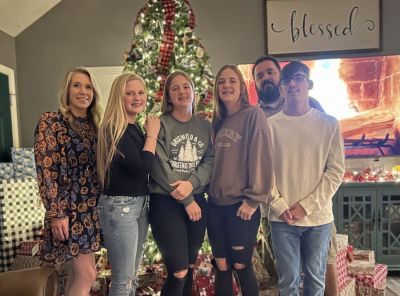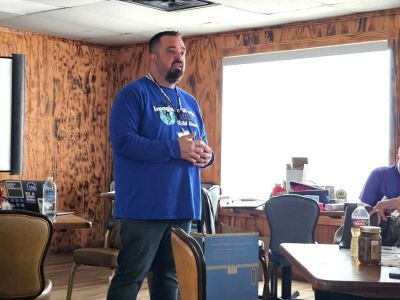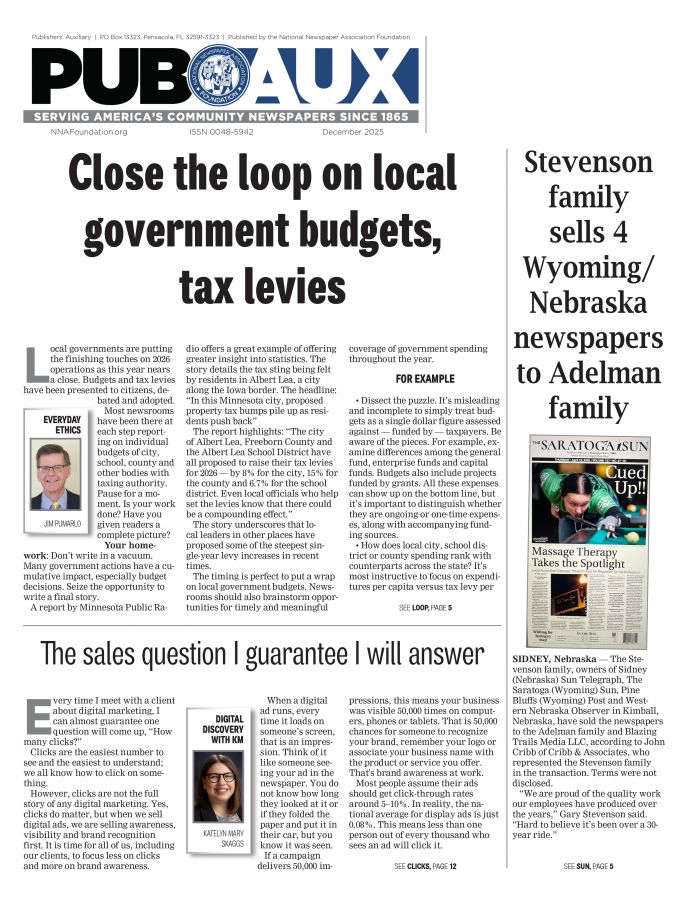Focusing on the future: With a nod to the past, Austin Lewter applies traditional journalism values to the modern platforms of today and tomorrow
Teri Saylor
Special to Publishers' Auxiliary
May 1, 2025



Austin Lewter is always on the move.
If he’s not at his newspaper in Whitesboro, Texas, he might be teaching in a Tarleton State University classroom about 140 miles away in Stephenville. He could be visiting a newspaper publisher out in the Texas Panhandle on behalf of the Texas Center for Community Journalism, or at a meeting of the National Newspaper Association Foundation’s board, to which he was elected a few months ago.
Lewter, who wears many hats, has a front-row seat at the intersection of the past, the present and the future of local journalism. He is laser focused on bright days ahead for publishers who are willing to embrace new tools and platforms for covering their communities while at the same time honoring the roots of small-town newspaper publishing.
At 42, he has played a role in community newspapers for nearly three-quarters of his life, starting as a pre-teen photojournalist at the newspaper he now owns with his wife, Jennifer.
And today, he’s a part of a paradigm shift in local news coverage and seeing the future unfold through his students, who represent the next generation of journalists and his own children.
Lewter’s twin daughters, Mackenzie and Isabella, recently filmed a short documentary about his work at the News-Record and the important role newspapers play in small town life. (View the documentary at https://bit.ly/4ixXQmy)
“The community newspaper tells the story of the folks in our community,” he says as the film opens. “When somebody’s born, when they have a birthday, when they graduate high school, when they get married, and when they die — all those things are in weekly newspapers.”
Lewter, who grew up in Whitesboro, began his lifelong affiliation with community journalism when his grandmother, Jacquita, was a reporter at the News-Record.
He can still view her byline on stories dating back over 30 years when she started working for the newspaper after retiring from her teaching career. He remembers afternoons after middle school when he’d walk down to the newspaper and watch her work, jumping into action when the police scanner squawked, and tagging along with her to cover stories.
When he was in the 7th grade, he started shooting photos at the local high school football games.
Lewter’s mother also worked at the newspaper, making up ads in the composing room near the very spot where his desk sits.
“I spent a lot of my childhood right here in this office,” he said in a recent Zoom call. “It was so different back then.”
The Whitesboro News-Record was founded in 1877 on the western edge of Grayson County, about 70 miles north of Dallas. Lewter’s family has been there since right after the Civil War.
He credits former News-Record publisher and mentor, the late Jim Davison, with instilling in him the values of community journalism. He and his wife, Xina, had bought the newspaper in 1973 and sold it to Texas newspaper man Scott Wood in 2008.
Lewter worked at the News-Record twice, once under Davison and later under Wood, finally purchasing the paper from Wood in 2023. After working there all his life, buying it was like coming home. He described the experience in a 2024 column celebrating Davison’s life.
“Life had a way of being serendipitous,” he wrote. “Mr. Wood called, and Jennifer and I closed our purchase of the newspaper in June 2023 as Whitesboro was celebrating its 150th birthday, 50 years to the month after Jim and Xina purchased the paper.”
THE ACADEMIC HIGHWAY
Lewter was already a journalism and broadcast instructor at Tarleton State University when he bought the News-Record. Twice weekly he makes the two-hour commute from Whitesboro to the Stephenville campus.
“I’m on campus on Tuesdays and Thursdays, and they’re long days — 12 or 15 hours sometimes,” he says, and admits that while his commute is a “bit of a haul,” he makes it work.
Jennifer Lewter manages the News-Record’s business operations, and Jessica Edwards is the managing editor. Lewter hired an advertising sales rep when he bought the paper, and he hasn’t looked back. It’s published on Fridays.
In 2007, Tommy Thomason, professor emeritus of journalism at Texas Christian University, launched the Texas Center for Community Journalism on campus and served as its executive director until he retired in 2019. The Center is funded with an annual grant from the Texas Press Foundation and Texas Press Services.
“Tommy started the Center with the express mission of providing professional journalism training at no charge to people working at community newspapers,” Lewter said.
When Lewter was exposed to the workshops as a newspaper publisher, he viewed Thomason’s career as a dream job. He earned a master’s degree in journalism and started teaching at Tarleton State University in 2021.
With Thomason’s retirement, TCU stopped hosting the Center, and it moved to Tarleton State University. In 2021, when the program needed a new executive director, Lewter stepped in to claim his dream job.
“The stars lined up just right, and I’ve been there for almost four years,” he said.
In addition to traditional newspaper management, writing and ad sales workshops, the Center hosts educational programs to teach publishers and editors how to diversify their operations into other forms of media like podcasting, video production and broadcasting. It has been a wildly popular track.
“The response for our broadcast workshop was overwhelming,” Lewter said. “I only had 30 seats in the room, but if I’d had a room that seated 60, I could have filled that, too.”
Lewter teaches four or five classes each semester and is also the faculty adviser for the Tarleton University student newspaper, which publishes daily online and in print six times per semester, he said.
“We’re building a culture of journalism with students doing good work and having fun,” he says. “Two girls who were engineering majors even joined the journalism program because they decided they didn’t want to be engineers.”
For Lewter, this work has become extremely rewarding, and he’s developed a passion for placing students in jobs.
“A publisher told me years ago that community newspapers will continue to exist only as long as there are people willing to staff them,” Lewter said. “Having a pipeline of reporters to hire is still one of their top concerns.”
Today’s student journalists bring unique skills and preferences, including a lifelong affinity for using apps and modern platforms for storytelling and news reporting. Lewter hopes traditional publishers will take notice.
“When I say ‘newspaper’ in a room full of 20-somethings, they roll their eyes, and I know I could have very well proposed publishing news on stone tablets,” he said. “If I can help bridge the generations in this industry, then that’s what I’m dedicated to doing.”
FOLLOWING HIS OWN ADVICE
At the News-Record, Lewter is committed to diversifying his own operations, putting his building to a higher use, blending the old with the new, and finding ways to attract an audience and build revenue.
He’s launched the Texoma Farm and Home, a glossy lifestyle magazine that circulates quarterly across his region from southern Oklahoma to North Central Texas.
He also continues to publish special sections at a rate of one or two per month and says those sections that were once gravy for community newspapers have become their meat and potatoes. He’s examining ways to get a higher use out of his Main Street newspaper building, including expanding his downtown retail footprint and launching a podcast.
“When we bought the newspaper, the biggest part of the sale was the building,” he said. “It has 3,500 square feet, and we really don’t need all that room, so our plan is to open a bookstore in the front and run the newspaper in the back.”
He also plans to add a small broadcast studio and is devising ways to monetize it, including producing podcasts for local businesses.
“Podcasting is a service you can provide to your community,” he said. “Not every business will buy a full-page ad in your newspaper, but many would love to have a podcast, and I think they’d pay someone to produce it.”
NIX THE NEWS DESERT MENTALITY
Lewter has read the studies on how newspapers are a dying breed of media, with more going out of business every day. He’s talked with other publishers who have thrown in the towel, but he refuses to give in to the shifting tides.
“I’m tired of the news desert narrative and the doom and gloom of it,” he says. “Yes, it’s a problem, and there are communities without newspapers, but the need for good journalism is always going to be there, and we have to be innovative about how we deliver it and monetize it.”
The fledgling journalists he teaches are already experts on platforms like Instagram and TikTok, and they know how to grow audiences and monetize their content. He sees them in action on campus.
“We have a fully functioning broadcast studio at Tarleton State, and I don’t know how to run it, but I don’t have to, because the students can do it,” he said.
Today, even young kids are experts with the Adobe suite, he added, and while they need to learn what a good layout looks like, they know how to insert pictures and words on a page, and they can always learn design techniques.
He also relies on his four high-school-aged children to help him navigate the digital story-telling landscape and gives a nod to his daughters, who filmed the documentary about his newspaper on their phones and edited it using the CapCut video–editing app.
They give him hope and energy for the future of journalism.
“My kids and the young people I see in my classroom are smart, bright and energetic, and they want to do good journalism,” he said. “It’s our job to let them do the work and give them space to thrive.“
One way is to channel the influencer mentality, and according to Lewter, if kids roll their eyes over newsprint journalism, some publishers and editors roll their eyes over influencers. But Lewter says influencing is an important pathway to monetizing digital content.
“I have a student who is an aspiring influencer and dedicates one day a week to producing TikTok content,” he said. “She's at a point now where she's getting paid to do it.”
Besides, he added, while influencer terminology and platforms are new, the concept is as old as the linotype machine.
“I told folks in northeast Texas recently that they need to embrace the term ‘influencer’ because the newspaper is really the oldest and the most trusted influencer in its community,” he said.
Midway through his career, Lewter has witnessed print journalism’s evolution, from the days the News-Record’s composing room was a hub of activity, through the advent and maturity of desktop publishing and the age of digital media.
As publishing news the traditional way becomes more difficult and expensive, some newspapers are closing, yet Lewter sees a light at the end of the tunnel and is determined to keep marching toward it with conviction that newspapers still have value and are not obsolete.
“At the end of the day, I fully believe newspapers aren’t dead yet, and that’s the hill I’m going to die on,” Lewter said.
Teri Saylor is a freelance writer in Raleigh, N.C. Reach her at terisaylor@hotmail.com










